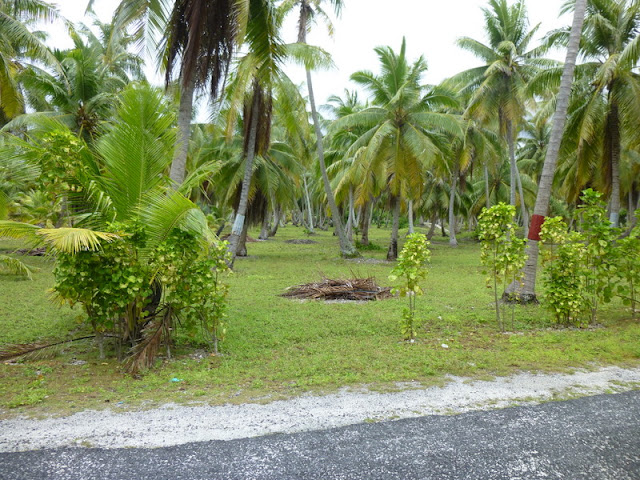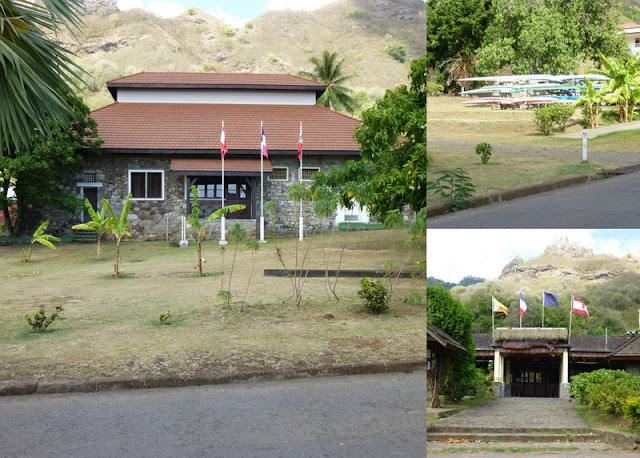January 13, 2013 en route to Rangiroa, Tuamotu Islands, French
Polynesia – Another Gray Day at Sea
Upping anchor and sailing from Nuku Hiva on the afternoon of
January 13, we set course west by southwest for our next port-of-call –
Rangiroa. Although we were south of the
equator and in the tropics, the sun continued to refuse to shine. So it was another cloudy, squally day, just
like the ones we had experienced on our way southwest from Los Angeles. Weather limited on-deck activities so sun
birds were restless. However, those of
us who mainly remained inside the hull (except for morning walks) were not
nearly as concerned. Listening to
lectures, playing cards, and trivial pursuit do not require sunny weather.
Given the continuing string of gray days and choppy seas,
all of us were ready for tropical sunshine on reaching Rangiroa atoll.
January 14, 2013 anchored off Rangiroa, Tuamotu Islands,
French Polynesia – Wet, Very Wet!
Rangiroa is not technically an island, but an atoll, which
consists of a surrounding coral reef, small, low-lying coral islands (motu),
and an inner lagoon. Rangiroa is a large
atoll, with a lagoon covering 750 sq. mi. encircled by a coral reef with over
240 motu rising from the reef. The generally-accepted
geological explanation for atolls is that they are remnants of an ancient
volcanic island that has eroded and/or undergone submergence, leaving only the
coral reef that encircled the island.
Silver Whisper entered Rangiroa lagoon through the Avatoru
pass in the coral reef and dropped anchor near the village of Avatoru. The ~3,000 persons who live on the atoll
largely dwell in two villages, Avatoru and Tiputa. Ship’s tenders took us ashore about five
miles from Avatoru, at the Ohotu pier.
Silver Whisper Entering Rangiroa Lagoon
Avatoru Pass is in
the background.
Village of Avatoru from Lagoon
The church is the
most visible building on the atoll.
Silver Whisper Tender at Ohutu Pier
Where is the
sun? The sky keeps getting darker and
darker.
J and E had decided not to participate in any of the ship’s tours
and went ashore after the tour rush at about 10:30am. It was another overcast, gray day, but we
decided to risk getting wet to have a walk on terra firma and see some of the
atoll. Near the pier were some
handicraft vendors and local musicians in temporary tents. There was also a café. Rangiroa is known for its cultured black
pearl industry, and the handicraft vendors sold locally-made jewelry, using
mother of pearl from the oyster shells and the black pearls. (Local use of black pearls indicates that
some of the pearls must have fallen off the back of the boat.)
Handicraft Vendors’ Tents Near Pier
Nothing makes you
more interested in handicrafts than a dry tent.
Leaving the pier area, we walked along the road, past local
homesteads with the usual collection of tropical fruit trees, children, dogs,
and feral chickens. We had just reached
the main road when a rain squall broke, and we were caught in a tropical
downpour complete with thunder and lighting.
(Luckily, Cooper was not with us, or we would still be hunting
him.) We took shelter with two other
Silversea couples in an abandoned grass shack (next to an abandoned, formerly
lived-in van) and waited for the rain to abate.
Finally, after about fifteen minutes, it did. This was fortunate, because by that time, the
palm fronds of the grass shack’s roof were acting like a sieve. So, it was back on the road and off toward
the pier.
The Main Road with Dog
The dog was in no
danger. Every animal on the atoll was
basically “free range.”
Local General Store
No shortage of
parking.
Coconut/Copra Plantation
Rule 1: Do not run under the coconut trees in a
squall. Bonk! Dead!
Rain Squall Coming Ashore
It got very wet and
windy about 60 seconds after this.
By the time we reached the pier, even with an umbrella, we
were soaking wet; however, we were not alone.
There were about 25 passengers and crew standing around waiting for the
next tender looking very wet, bedraggled, and very cold. To stay entertained, we went over to look at
the handicraft vendors’ offerings. (It
was also under a tent and fairly dry.) E
was especially taken by the mother-of-pearl/black pearl necklaces and helped
the local economy with a purchase.
After about 30 minutes, the tender arrived just in time for
the rain to stop. We were packed aboard
like the half-drowned rats we were, and taken back to the Silver Whisper, where
we had a hot shower and a hot lunch. It
is hard to believe that you could be so cold in the tropics.
Rain squalls continued the rest of the day, and the sun was
nowhere to be seen. Those who had gone
on tours to other motu, or snorkeling in the lagoon, returned looking as soaked
as those of us land lubbers who had simply tried to take a walk. At 5:00pm, we sailed for our next destination
in French Polynesia, Moorea. Still
looking for the sun.























































